-9%
Get Drive Belt Tensioner Assembly Volkswagen Jetta Hybrid 1.4L TSI Full Hybrid 03C145299M
The Drive Belt Tensioner Assembly is an essential component in a vehicle’s engine system, responsible for maintaining the correct tension on the serpentine or drive belt. This belt, in turn, powers multiple engine accessories such as the alternator, power steering pump, air conditioning compressor, and, in some cases, the water pump. Understanding the Drive Belt Tensioner Assembly, its function, and its significance in the vehicle’s overall performance is crucial for both car enthusiasts and everyday drivers. In this detailed explanation, we will explore the role of the Drive Belt Tensioner Assembly, its components, how it works, common issues, maintenance tips, and the benefits of keeping this part in good working condition.
Function of the Drive Belt Tensioner Assembly
The primary function of the Drive Belt Tensioner Assembly is to apply the correct amount of tension to the drive belt. The drive belt needs to be neither too loose nor too tight to function effectively. If the belt is too loose, it may slip off the pulleys, leading to a loss of power to the engine accessories and potentially causing the engine to overheat or the battery to discharge. Conversely, if the belt is too tight, it can cause excessive wear on the belt itself and the components it drives, leading to premature failure.
The tensioner assembly ensures that the belt remains properly tensioned under all operating conditions. It automatically adjusts the tension as the belt stretches over time due to wear and tear, temperature changes, or engine vibrations. This self-adjusting mechanism helps to prolong the life of the belt and the components it drives, reducing the need for frequent manual adjustments.
Components of the Drive Belt Tensioner Assembly
The Drive Belt Tensioner Assembly consists of several key components that work together to maintain proper belt tension. These include:
- Pulley: The pulley is the component that directly interacts with the drive belt. It is typically made of metal or high-strength plastic and is designed to guide the belt along its path. The pulley rotates on a bearing, allowing it to move smoothly as the belt travels over it.
- Spring Mechanism: The spring mechanism is the heart of the tensioner assembly. It provides the necessary force to keep the belt under tension. The spring can be a coil spring, torsion spring, or flat spring, depending on the design of the tensioner. The spring’s tension is calibrated to maintain the correct belt tension throughout the belt’s life.
- Arm: The arm is a lever that connects the pulley to the spring mechanism. It allows the pulley to move in response to changes in belt tension, enabling the assembly to adjust automatically as needed.
- Base/Bracket: The base or bracket is the component that secures the tensioner assembly to the engine block. It is typically made of metal and is designed to withstand the forces generated by the tensioner during operation.
- Damping Mechanism (Optional): Some tensioners include a damping mechanism, which helps to reduce vibrations and oscillations in the belt system. This can be particularly important in high-performance engines or vehicles with complex belt routing.
Benefits of a Well-Maintained Drive Belt Tensioner Assembly
Maintaining the Drive Belt Tensioner Assembly in good condition offers several benefits for your vehicle:
- Consistent Performance: A properly functioning tensioner ensures that the drive belt remains correctly tensioned, allowing the engine accessories to operate efficiently and consistently.
- Extended Belt Life: By maintaining the correct tension on the belt, the tensioner helps to reduce wear and tear, extending the life of the belt and reducing the need for frequent replacements.
- Reduced Risk of Failure: Regular maintenance of the tensioner assembly reduces the risk of sudden belt failure, which could leave you stranded or cause damage to other engine components.
- Improved Fuel Efficiency: Properly tensioned belts reduce the strain on the engine, leading to improved fuel efficiency and overall vehicle performance.
- Quiet Operation: A well-maintained tensioner assembly reduces noise and vibrations in the belt system, contributing to a smoother and quieter ride.
Signs of a worn out Drive Belt Tensioner Assembly
1. Squealing or Chirping Noises
- Symptom: A high-pitched squealing or chirping noise coming from the engine, especially when the engine starts or when accelerating.
- Cause: This noise is often due to a loose or slipping drive belt caused by insufficient tension from a failing tensioner. The belt may not be properly aligned or could be slipping on the pulleys.
2. Belt Misalignment
- Symptom: The drive belt appears to be misaligned, sitting crooked on the pulleys, or showing signs of uneven wear.
- Cause: A worn-out tensioner may not keep the belt aligned correctly, leading to the belt slipping off the pulleys or wearing unevenly. This misalignment can also cause the belt to fray or crack prematurely.
3. Visible Wear on the Belt
- Symptom: The drive belt shows signs of excessive wear, such as cracks, fraying, glazing, or chunks missing from the belt.
- Cause: A malfunctioning tensioner can cause the belt to rub against pulleys incorrectly, leading to accelerated wear. Over time, this can result in the belt snapping or failing entirely.
4. Rattling or Knocking Sounds
- Symptom: A rattling or knocking sound coming from the front of the engine, particularly at idle or low RPMs.
- Cause: The pulley bearing or the tensioner arm may be worn out, causing the pulley to wobble or the tensioner to move erratically. This can produce a rattling or knocking noise as the components move out of sync with the belt.
5. Engine Accessories Malfunctioning
- Symptom: The alternator, power steering, air conditioning, or other engine accessories start to malfunction or operate intermittently.
- Cause: If the tensioner is not maintaining proper tension on the belt, these accessories may not receive enough power, leading to erratic operation. For example, the alternator may not charge the battery effectively, or the power steering may become less responsive.
6. Loss of Power Steering or AC
- Symptom: Sudden loss of power steering or air conditioning functionality while driving.
- Cause: A loose or slipping belt due to a faulty tensioner can cause these systems to fail temporarily. This is especially noticeable during sharp turns or when the AC is under heavy load.
7. Check Engine Light
- Symptom: The check engine light comes on, often accompanied by other symptoms such as rough idling or loss of power.
- Cause: In some cases, a failing tensioner can lead to the belt slipping off entirely, triggering the check engine light as engine sensors detect the resulting malfunctions in the accessory systems.
8. Vibrations or Shaking in the Engine
- Symptom: Unusual vibrations or shaking in the engine, particularly at certain RPMs or when the engine is under load.
- Cause: A worn-out tensioner may fail to dampen vibrations from the belt system effectively. This can cause the belt to oscillate, leading to noticeable vibrations throughout the engine bay.
9. Frequent Belt Adjustments
- Symptom: The drive belt requires frequent manual adjustments to maintain proper tension.
- Cause: If the tensioner is failing, it may not be able to maintain consistent tension on the belt, necessitating frequent adjustments or belt replacements.
10. Visible Damage to the Tensioner Assembly
- Symptom: Upon visual inspection, the tensioner assembly shows signs of wear, such as cracks, rust, or a bent arm.
- Cause: Physical damage to the tensioner assembly can prevent it from functioning correctly. This damage may be due to age, exposure to the elements, or mechanical stress.
Maintenance and Replacement of the Drive Belt Tensioner Assembly
Proper maintenance of the Drive Belt Tensioner Assembly is essential for ensuring the longevity and performance of the engine’s drive belt system. Regular inspections can help identify potential issues before they lead to more serious problems.
- Visual Inspection: Periodically inspect the tensioner assembly for signs of wear, damage, or contamination. Look for cracks, bends, or signs of corrosion on the arm and bracket, and check the pulley for wobbling or unusual noises.
- Listen for Noises: Unusual noises, such as squealing or rattling, may indicate a problem with the tensioner assembly. If you hear these noises, it’s a good idea to have the tensioner checked by a professional mechanic.
- Check Belt Tension: If the belt appears loose or shows signs of excessive wear, it may be time to replace the tensioner assembly. A loose belt can cause the accessories to operate inefficiently, leading to decreased vehicle performance.
- Replace Worn Components: If any part of the tensioner assembly shows signs of wear or damage, it’s important to replace it promptly. In most cases, it’s recommended to replace the entire assembly rather than individual components, as this ensures optimal performance and compatibility.
- Regular Belt Replacement: Since the tensioner assembly is designed to work with the drive belt, it’s important to replace the belt at the manufacturer’s recommended intervals. A new belt will work more effectively with the tensioner, prolonging the life of both components.
Follow us on Facebook for more parts.



